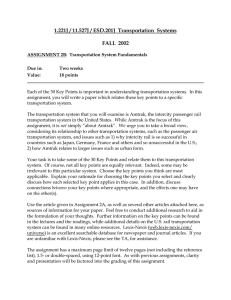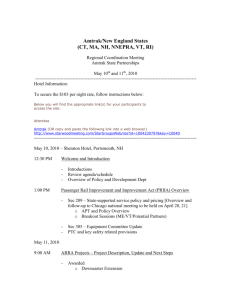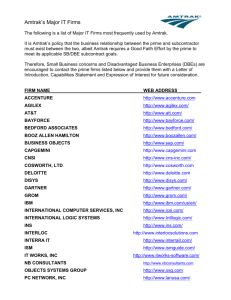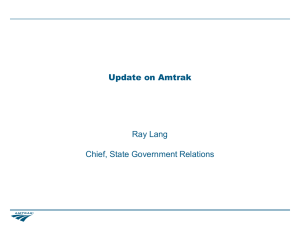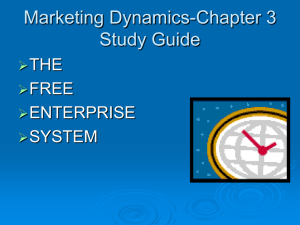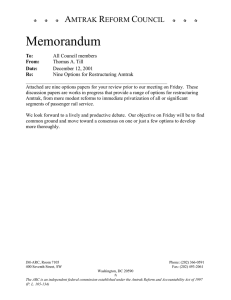An Action Plan for the Restructuring and Passenger System
advertisement
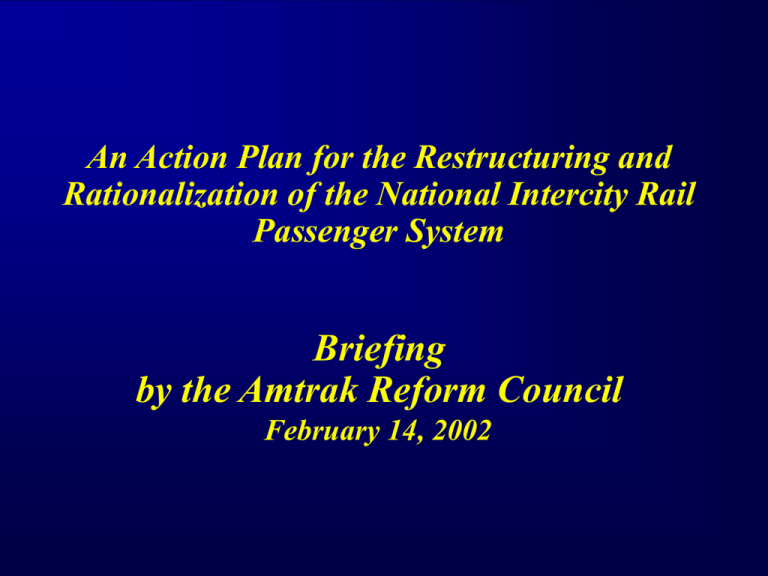
An Action Plan for the Restructuring and Rationalization of the National Intercity Rail Passenger System Briefing by the Amtrak Reform Council February 14, 2002 Amtrak’s ridership is growing very slowly. Amtrak has a very small share of the intercity travel market Airlines Intercity Bus Carriers Amtrak 2000 Ridership 610,000,000 42,000,000 22,500,000 Amtrak Intercity Ridership FY1972 -- FY2002 60.0 50.0 40.0 30.0 20.0 10.0 2000 1998 1996 1994 1992 1990 1988 1986 1984 1982 1980 1978 1976 1974 - 1972 millions of riders 70.0 Amtrak Reform Council Amtrak’s Financial Performance Amtrak Financial Performance, FY1997 -- FY2001 $1,200 GAAP Loss GAAP Loss GAAP Loss GAAP Loss $1,073 million $930 million $916 million $943 million $1,000 $183 ($ millions) GAAP Loss $762 million $142 $800 $82 $142 $166 $103 $178 $248 Capital contribution to operating (progressive overhauls) $90 $37 $600 $66 Depreciation/non-cash expenses $488 $405 $337 $383 Operating loss for purposes of selfsufficiency $400 $200 $335 Est. Excess Mandatory Railroad Retirement $301 $310 $292 Operating contribution to capital $341 $(5) $FY1997 FY1998 FY1999 FY2000 FY2001 Amtrak Reform Council The Council’s plan is based on three concepts for reform • A new business model for Amtrak • The option to introduce competition • An adequate and secure source of funding Amtrak Reform Council The new business model separates Amtrak’s functions into three components • Government program administration and oversight – Funding – Corridor Development – Oversight • Train operations – A separate company with a strong business board to focus on market oriented services • Infrastructure – A separate federal government entity to own and manage the NEC infrastructure Amtrak Reform Council Federal Program Management and Oversight • The National Rail Passenger Corporation (NRPC) would be restructured as a small government entity – The NRPC would be modeled after USRA’s role monitoring Conrail to manage the intercity rail program – A board of directors representing states, the federal government, the freight railroads, and rail labor Amtrak Reform Council Federal Program Management and Oversight • The NRPC would: – Secure and administer federal funding – Approve business plans of the operating and infrastructure entities and monitor their implementation – Manage franchising of train services – Lead high-speed rail corridor development Amtrak Reform Council Federal Program Management and Oversight • The NRPC would: – Hold the statutory franchise to access freight railroad rights-ofway – Make insurance available to train operators – Divest non-NEC assets – Ensure the NEC infrastructure company is brought to a state of good repair – Preserve and improve a national reservations and ticketing system Amtrak Reform Council Train Operations • The new train operating company would be a subsidiary of the NRPC – All services would be provided under contract with performance standards (similar to Amtrak’s commuter operations today) – All services would have separate, transparent accounting – A board of business professionals with expertise in transportation, operations and finance Amtrak Reform Council Optional Franchising of Train Operations • The NRPC would evaluate the merits of franchising specific services during an initial transition period (2 to 5 years) • Contracts would be let through a competitive bidding process for both profitable and unprofitable services • The need for adequate track capacity would be taken into account in designing and awarding franchises Amtrak Reform Council Optional Franchising of Train Operations • If franchising is implemented, the Council also recommends that: – All franchisees be subject to the Railway Labor Act, Railroad Retirement and FELA – Existing Amtrak employees be given a right of preferential hiring with new train operators – Employees follow their work in seniority order with their collective bargaining agreements intact. Contracts could be renegotiated pursuant to the Railway Labor Act Amtrak Reform Council NEC Infrastructure • A new subsidiary of the NRPC would own, maintain, and upgrade the NEC – The board of directors would be made up of representatives of the NEC states, the federal government, freight carriers on the NEC and the train operator Amtrak Reform Council An adequate and secure source of funding • Even with reform, the cost of the intercity passenger rail program will be considerable – Current annual operating subsidies are about $600 million – About $100 billion of funding over 20 years to develop all high-speed corridors including returning the NEC to a state of good repair Amtrak Reform Council Conclusion • The Council’s Action Plan will provide: – An effective rail passenger program – More economical and higher quality services – The Congress with the confidence to fund the rail passenger program that the country wants and needs Amtrak Reform Council
